McGill News makers 1999
For the second year in a row, we proudly present our round-up of the top McGill stories for the year just ended. Since our feature last January was well-received (and since it spares me from having to come up with any new ideas), we decided to do it again.
As was the case last year, we used an assortment of news databases and web sites to compile a list of the McGill stories that earned the most ink and broadcast time.
We only counted one appearance on a TV show or in a newspaper — obstetrics and gynecology professor Roger Gosden was the subject of a few stories in the National Post, for instance, but we only counted that publication once for our purposes.
To make the list, a story has to mention a researcher's work as well as her ties to McGill.
So what attracts the media's attention?
"It depends greatly on the publication or the program and its audience," says Diana Grier Ayton, manager of communications for Development and Alumni Relations and editor of McGill News.
"Of course, there always has to be a 'wow' factor in a story, but often a cure for baldness or a pill for weight loss is going to get much more attention than the discovery of a new particle of matter.
"Then there are the practical considerations: 'We've already done three stories on cloning — it's getting old.' 'No pictures? Forget it.'
"If a story is very complex, then the scientist has to be able to present it well," Grier Ayton adds. "He or she also has to be available. You can't launch a story of a great discovery and then say you're too busy in your lab to answer any questions."
Biology professor Louis Lefebvre teaches a course called "Perspectives of Science" that examines, among other things, why some science stories attract more media attention than others.
He and his students tabulated the types of science stories that tend to be the most popular. Anything to do with outer space was the hottest area, followed by stories dealing with medicine (including genetics and molecular biology). Number three was a surprise.
"Paleontology and archaeology are very popular. People are really interested in dinosaurs. I don't know if that's a Jurassic Park effect."
Lefebvre notes that a paper appearing in one of the heavyweight journals — Science, Nature, New England Journal of Medicine or The Lancet — has a far greater chance of capturing media attention than research published elsewhere.
"If it's in these journals, [the media] knows it's prestigious," explains Lefebvre.
But he says another factor is also at play. These publications have their own teams of public relations experts who tip off the media about a handful of papers in each issue of their respective journals.
These people alert the press to breakthroughs that are considered to be especially significant and explain the research to them in laymen's terms. "They do half your work for you if you're a journalist," says Lefebvre.
Kate Williams, director of the University Relations Office, says the first test of newsworthiness "is whether the news promises direct improvements to people's lives."
Says Williams, "News stories are memorable if they have a human interest element to them. That's why so many stories start off with something like 'Jonathon Lang woke up one morning and found he couldn't move...' Something like that tugs at the heartstrings."
It also helps "if the story relates to public concerns, like toxic waste or genetically altered plants."
Scholars have to do some of the work if they want their research covered, stresses Williams. "It's important to minimize professional jargon. There can be so much opaque language" in a university.
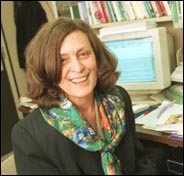 Mary Dean Lee
Mary Dean Lee
| |
Management professor Mary Dean Lee is McGill's undisputed media darling for 1999. Lee led a team of researchers from McGill and Purdue University that looked at what happened to the career prospects of managers and professionals who work part-time.
The surprise finding was that switching to part-time status didn't seem to cause any damage to how these workers were viewed by their employers. Two-thirds of the part-time professionals and managers who were surveyed told Lee and her colleagues that their careers hadn't been harmed by their decisions to eschew 40-hour work weeks. In fact, 35 per cent of these workers even earned promotions as part-timers.
Lee said the results "just bowled us over," but cautioned that part-time arrangements work best for top performers who have enough clout with their employers to negotiate the hours in their work weeks. Seventy different media covered Lee's work, including NBC Nightly News, CTV National News and Los Angeles Times.
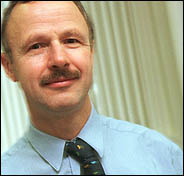 Roger Gosden
Roger Gosden
| |
Obstetrics and gynecology professor Roger Gosden only started working at McGill in October, but he sure wasted no time making a name for himself.
Shortly before he arrived at the University, a story broke about a remarkable surgical procedure Gosden had developed. The ovarian grafting technique was created to help young women protect their future fertility in the face of threats from premature menopause or cancer treatments.
The idea is to remove segments of ovaries from women before their fertility is impaired, freeze the ovarian material, and then graft it back inside once the threat has passed.
A woman who underwent the procedure in New York began ovulating again after receiving the graft.
The coverage was probably a double-edged sword for Gosden — many of the initial headlines claimed that he was close to "reversing" menopause and raised the prospect of 60-year-olds having babies. Although Gosden downplayed that sort of speculation, the claim stuck in the craw of some media pundits who didn't think menopause was something that needed to be reversed.
CBC Newsworld's Judy Rebick wrote, "Perhaps Professor Gosden or one of his colleagues will find a way to reverse puberty for parents who can't stand adolescents."
Forty-two media reported on Gosden's work, including The Independent, La Presse and CBC Television's Sunday Report.
 Seang Lin Tan
Seang Lin Tan
| |
It was an awfully good year, news-wise, for the McGill Reproductive Centre. That's where Gosden is currently pursuing his research and it's also where obstetrics and gynecology professor Seang Lin Tan plies his trade.
Tan became the first doctor in Canada to perform another innovative new procedure, called in-vitro maturation.
Similar to in-vitro fertilization, which involves giving women hormones to mature their eggs and then removing the eggs for fertilization in a lab, the new technique is cheaper, requires fewer drugs and involves fewer side effects. With IVM, women receive only one shot of hormones and their embryos are grown outside their bodies for longer periods of time.
Not everyone was thrilled by Tan's work. Professor Margaret Somerville, from the Centre for Medicine, Ethics and Law, told CBC News that "scientists are charging ahead with reproductive technology...without watching where they're going." Jihan Alkharouf, one of Tan's research subjects and a new mother thanks to the technique, stated that "IVM is the perfect joining of religion and technology, that resulted in life where none had been possible before."
Tan's work was covered in 23 media including Canada AM, CBC's National and Philadelphia Daily News.
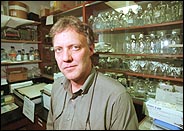
Michael Meaney | |
Psychiatry professor Michael Meaney struck a blow for nurture over nature last year. Meaney led a McGill team that published a paper in Science indicating that a child's personality traits are influenced more by parents' behaviour than by genes.
The study, which focused on rats, noted that pups whose mothers licked and groomed them often and nursed them in a certain arched-back position became less fearful than pups with more "reserved" mothers.
Pups brought up by attentive foster mothers coped better in stressful new situations than those nurtured by birth mothers who were more reserved. Meaney and his colleagues concluded that the actions of mothers in the early days of the pups' lives might play a greater role in influencing the animals' personalities than genetically inherited traits.
The research attracted the attention of 21 media including BBC News, The Washington Post and The Toronto Star.
Michel Tremblay | |
Sharing fourth place with Meaney is biochemistry professor Michel Tremblay. Along with post-doctoral fellow Mounib Elchebly and scientists from Merck Frosst, Tremblay discovered an enzyme in mice that seems to be linked to obesity and type II diabetes. The absence of protein tyrosine phosphatase-1B (PTP-1B) results in slimmer, healthier mice.
Tremblay and his team genetically altered mice to suppress the gene responsible for the production of the PTP-1B enzyme. Their success prompted hopeful speculation that an effective drug treatment for obesity and type II diabetes might be possible one day.
Tremblay cautions people not to get too excited just yet. "We can't think there will be one magic bullet. One drug to do all that would be misleading."
His work was covered by 21 media including Scientific American, New York Post and Financial Times.
Surgery professor Orest Blaschuk is the next researcher on our list. He led a team of scientists from McGill, Georgetown University, Israel's Weizmann Institute and other centres in developing a new drug called Exherin.
The drug kills blood vessels that feed cancerous tumours. Tests with mice indicate that the treatment stops the growth of tumours in 24 hours. Exherin blocks the adhesive proteins that hold blood vessels together and it targets only the vessels in tumours.
"This is a radical new approach," Blaschuk told the National Post. "No one ever thought of targeting cell adhesion as a way of stopping tumour growth." Medicine professor Barbara Gour also played a leading role in the development of Exherin.
Sixteen media covered the story including The Globe and Mail, The Journal de Montréal, and New York Daily News.
 Richard Menzies
Richard Menzies
| |
Epidemiology and biostatistics professor Richard Menzies also attracted notice from 16 media, including The Ottawa Citizen, Canada AM and The Guardian.
Menzies thinks he's come up with an effective weapon in the war against sick building syndrome — the collection of ailments (scratchy throat, headaches, itchy eyes, fatigue) that office workers in poorly ventilated, closed window structures commonly complain about.
Menzies noted that bombarding air-conditioning units in ventilation systems with ultraviolet light seems to impede the growth of harmful microbes, fungi and bacteria. A preliminary study showed a 15- to 20-per cent reduction in complaints from staff when this strategy was employed. "There was a trend to fewer symptoms and less time off work," Menzies told The Gazette.
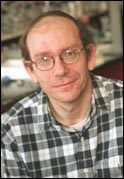 Moshe Szyf
Moshe Szyf
| |
Pharmacology and therapeutics professor Moshe Szyf's work appeared in 14 media last year, including New Scientist, La Presse and The Edmonton Journal.
Szyf led a McGill team that discovered a new gene that might be able to "deprogram" cells in the body and reverse diseases like cancer. An enzyme called demethylase was found to play a large role in changing how individual cells operate.
If scientists learn how to use demethylase to modify cell function, they might be able to stop cancerous cell production in its tracks. They might also be able to build custom-made organs for transplantation with no fear that they would be rejected by the patient's body. "We've been missing the microchips of biotechnology that we need and now we think we've found one of them," Szyf told Canadian Press.
Educational and counselling psychology professor Jeffrey Derevensky is one of two professors who also made our top 10 for 1998. Together with departmental colleague Rina Gupta, Derevensky examines how adolescents develop debilitating addictions to gambling. Video lottery terminals (VLTs) are often the culprits that get them hooked — adolescents, reared on video games, are attracted to the similar-looking VLTs.
"Adolescents, particularly males, are more attracted to risk-taking activities than adults. As long as gambling is seen by them as an exciting, risk-taking activity, they will be drawn to it," Derevensky told the Reporter.
Derevensky and Gupta's work was covered by 13 media, including Canadian Living, Calgary Herald and CBC's The National.
French language and literature professor François Ricard also earned 13 mentions in different media. An English translation of Ricard's French-language biography of author Gabrielle Roy was published to great acclaim. Patricia Claxton won a Governor-General's Award for her translation, while Ricard earned the inaugural Drainie-Taylor Biography Prize for best biography written by a Canadian.
Thirteen media reported on Ricard's book, including CBC Radio's The Arts Today, Le Soleil and the National Post. Despite his success with Gabrielle Roy: A Life, don't expect any more biographies from Ricard any time soon. The book took 10 years to research and write. "It's the first [biography] I've ever written and it's the last I'll ever do," Ricard told the Reporter.
 Amanda Vincent
Amanda Vincent
| |
Another returnee from last year's top 10 list is biology professor Amanda Vincent. Vincent is generally regarded as the world's top expert on seahorse biology and she also leads an international effort aimed at protecting the beautiful creatures from over-fishing. (Seahorses are widely used in Chinese traditional medicine.)
Vincent's work got a big boost recently when she struck up a partnership with Belgian Chocolaterie Guylian. The company granted her $750,000 U.S. for her work and will promote her conservation efforts in every box of its top-selling brand of chocolates. Her work was the subject of stories in Time (which named her one of its young leaders for Canada), National Public Radio's All Things Considered and L'Actualité.
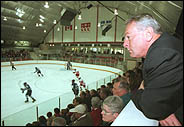 Richard Pound
Richard Pound
| |
In terms of non-research stories, the big news was about Richard Pound becoming McGill's newest chancellor. The New York Times and other non-Montreal media aren't generally too interested in McGill's chancellor, but they made an exception this time. Pound's appointment became official just as he was winding down a high-profile investigation into wrongdoing by fellow members of the International Olympic Committee.
Second spot goes to law professor Irwin Cotler's successful bid to become the Liberal Party's new MP for the riding of Mount Royal. It was front page news in the National Post and even attracted attention in The Jerusalem Post and The Miami Herald.
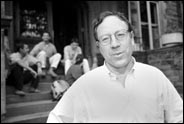 Irwin Cotler
Irwin Cotler
| |
As far as graduates go, the most mentioned (in connection to their time at McGill) was astronaut Julie Payette. Accomplished (she's an engineer, a pianist, a flutist, a triathlete and speaks several languages), charming, and blessed with girl-next-door good looks, Payette managed to captivate even the U.S.-centric American media last May when she served on a mission aboard the space shuttle Discovery. Payette earned admiring profiles in The Boston Globe, Houston Chronicle and elsewhere. Needless to say, there was coverage aplenty in Canada: Maclean's, Homemakers, 7 Jours, even Frank.
Second place was a tie between Robert Rabinovitch, the CBC's new president (and the chair of McGill's Board of Governors) and ex-Montrealer Vaira Vike-Freiberga, the new president of Latvia.
Other graduates whose McGill ties were mentioned often include Star Trek icon William Shatner, software entrepreneur and author Ellie Rubin, Nortel Networks CEO John Roth, TV host/filmmaker Alexandre Trudeau (son of you-know-who) and inventor Paul Moller, who just might revolutionize transportation with his patented Jetsons-like air car.

